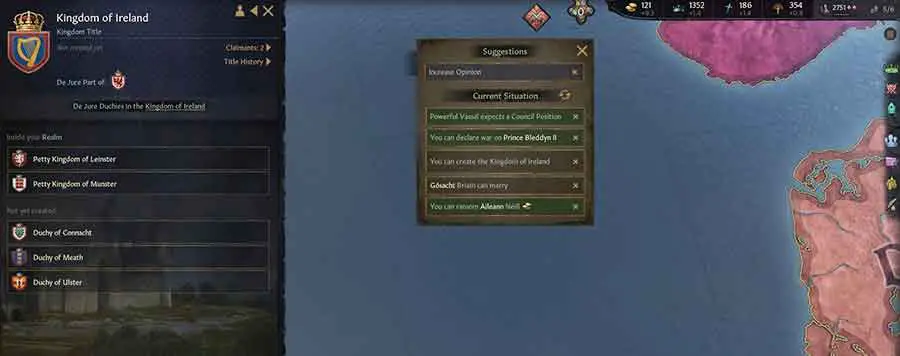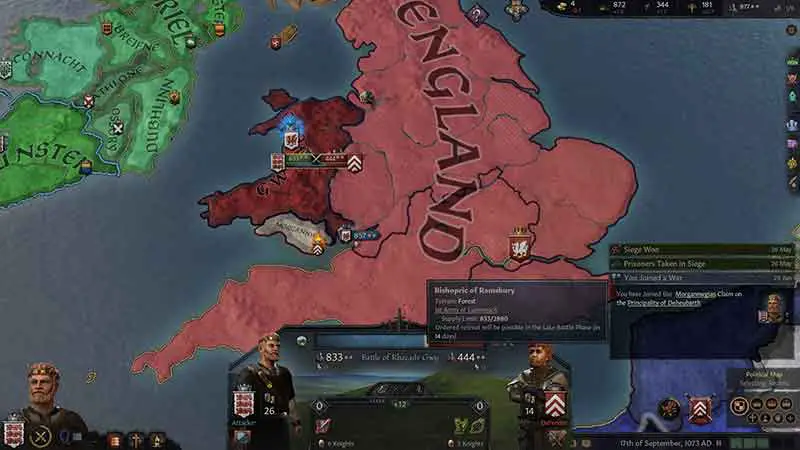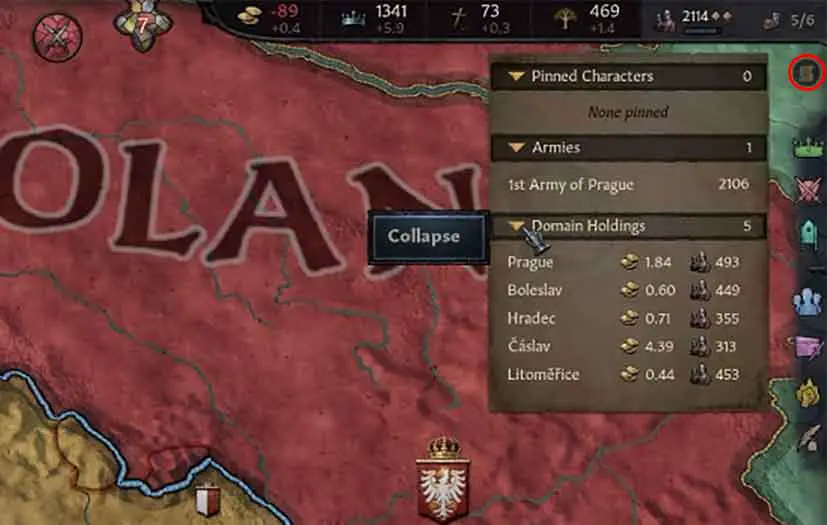
Crusader Kings 3 is another sequel to the ever-popular Crusader Kings series. It’s a pausable, real time strategy game set in medieval times. It’s a game that’s designed to never let you “officially” win but growing your empire with all the complexities involved makes it a very entertaining game to play. The game can end though if you die without having an heir to your throne.
The Crusader Kings 3 learning curve is steep but not insurmountable. Obviously, playing the tutorial will help reduce it. The next best thing to do is let the game guide you through the process of learning, even after the tutorial is “officially” over. After about 10 hours of gameplay you should have a solid understanding of the game concepts.
One of the best features about this game is that there is “no best way” to play. You play the way you’d like, and even an apparently devastating mistake won’t knock you out of the game. The learning curve, in my opinion, is steeper than Stellaris, which is the first Paradox game I feel like I’ve sort of mastered and understand.
Having trouble with some pesky vassals? Take a look at this page on my website and learn how to manage them.
Stuff With A Learning Curve
I found the titles and the differences between Domains and Earldoms hard to keep straight but with a little practice and help from the game I started understanding them a little better. The biggest issue was remembering the hierarchy. This will just take a lot of gameplay and practice and for me the learning curve is steep.
I found learning the basic concepts of the characters to be relatively easy since it’s pretty similar to other games I’ve played. You click on your character’s portrait to get a look at his or her traits, what your religion is and what your player heir’s opinion of you is. There is no real learning curve when it comes to character stats. Even interacting with other characters is pretty simple once you’ve done it a few times and remember how.
The learning curve for resources is also not very steep, especially if you’ve played strategy games before. You can see how much of a resource you have, like gold or prestige, in the upper right corner of the screen. Hovering the mouse cursor over the numbers will cause a tooltip to appear giving you a breakdown of the income and outflow for that resource.
Crusader Kings 3 Lifestyles, Titles, And Land
Character lifestyles is a little trickier for me. There are five lifestyles to pick from and these represent what you put most of your effort into, like a militaristic lifestyle. Some characters will get an automatic bonus for a certain lifestyle, so usually choosing that one makes the most sense. Embedded in each of these lifestyles is a “focus,” which essentially gives you perks in certain areas as you play the game.
The focuses will be a little confusing to any newcomer to the game like me. A brief synopsis of each focus is listed at the left of the screen, but the synopsis name and the actual choice titles are only loosely associated with each other. For instance, the summary on the left for Strategy Focus is actually the Strategist tree on the right. Confusing but not too hard to figure out. Making the best choice is not obvious but all the choices are good, you just need to decide which is the best one for the current situation.
Titles and land, at least for me, was a different story, and by far are the most difficult for me to understand and learn, as I said earlier. There are four types of land, County, Duchy, Kingdom, and Empire, each ruled by a different type of ruler. There are also Barons, who are the lowest ranking ruler. This ruler only has one holding and is answerable to a Count. And just to make it more interesting, each title is answerable to the next ruler up in the chain of command, at least technically if not in real practice. The game calls this De Jure title hierarchy.
The land is broken down into baronies (holdings), which are part of a county. The baronies are actually settlements in your domain, similar to an early version of a city. There are also buildings to construct in these and taxes to collect. I found this to be, by far, the single biggest element responsible for the steep learning curve when it came to comprehending all the subsystems in the game.
There are a lot more subsystems to learn, like renown and succession laws but they don’t seem to be too difficult to understand.
Next to the titles and land, the next most complex thing to learn is how all the numerous subsystems in the game interact.
War In Crusader Kings 3

I found the learning curve for war a little difficult to master at first. For me war is one of the most enjoyable parts of any game but this game does not put a great emphasis on tactics and battles. Unlike my first playthrough of the tutorial, for some reason, in my second playthrough, my siege at Tralee failed and I ended up losing the war, the tooltip said my attacking army was smaller than the garrison at the settlement and the siege would not continue. I thought maybe I didn’t wait long enough to raise all my armies before marching off to combat so I played the tutorial a third time to figure out exactly what went wrong.
Read More: Before you can declare war in CK3 you need a Casus Belli. Find out exactly what that is and how to get it at my Casus Belli page. You can also use the customized menu at the top of the page to see all my CK3 articles. If you want to get a general idea about the game check out my CK3 overview page.
This time I waited longer after declaring war and raising armies to march off to my objective but still could not take Tralee. Once again, the tooltip said the garrison at the city had more troops than my army did. The difference between the first playthrough and this one was the fact that I didn’t engage any enemy armies along the way, which left me with enough troops to conduct a successful siege. I created a heavy infantry unit for reinforcements, just like I did in my second tutorial playthrough, but just like last time they remained unraised and did not reinforce my army. I remembered that I needed to click the raise all armies icon to finish creating them. Once that was done, they marched out and reinforced my army, allowing me to gain a warscore of 100 once the garrison was defeated. I then enforced my demands.
One other confusing thing that took a little while to figure out was who was an ally, which army was actually my army, who the enemy armies were, and how to identify the enemy settlements when looking at the map. The method for identifying armies is not difficult at all once you understand the color coding, green emblems for your army, blue for allies, and red for enemy. There is nothing notable, at least that I could tell, that identified an enemy settlement, the only clue I had was that the territory I was attacking was outlined in red. There may be a map view available to make it easier, but I haven’t found one yet, guess that’s part of the learning curve. This is definitely not a game for beginners in my humble opinion.
War can be waged efficiently but you need to be aware of all the little things that can go wrong, like forgetting to raise a unit after it is created.
Read More: If you’re going to war your going to need friends. You can learn to get them at my alliance page.
Reducing The Learning Curve
The best and most obvious way to lower the slope of the learning curve is to play the tutorial, which starts you out as the Petty King Murchand, who is one of many rulers in Ireland. The game even gives you a suggested goal, to become the King of Ireland. Since I was learning the game I thought that would be a good goal to take on, although I didn’t have the faintest idea about how to do it. I decided to rely on my militaristic abilities and just start conquering my neighbors.
Playing the start of the tutorial will take about an hour, when the “What Now” screen pops up you know the tutorial is close to being “officially” over although lessons still pop up, just less frequently than they did before. I ended up playing the tutorial through 3 times, playing the tutorial again for the third time took about 35 minutes. In all I played the tutorial about 2.5 hours. To replay the tutorial, click the “Play Tutorial” button in the upper right corner.
The reason I played the tutorial 3 times was because I did not finish the tutorial the first time through, I was interrupted and didn’t finish it until a few days later, which was a mistake. The problem I ran into was that I couldn’t remember how to do a lot of basic things, like how to marry off an heir. So lesson number 1 is to complete the tutorial in one session and then play the game for at least a few more hours after that to cement what you’ve learned into place. The third playthrough was to figure out what went wrong with my war effort, which I already talked about. My advice is to play the tutorial at least twice if you’re having trouble with some of the basics in the game.

Examine the User Interface thoroughly! Don’t ignore any icons because they all do something or tell you something! That pretty little scroll in the upper right corner of the map (circled in red), don’t ignore it! Clicking on it expands the Outliner, giving you a quick and easy way to select characters, armies and holdings.
The tutorial will take you through all the basic game mechanics like camera movement and tooltips, just like any other game, so I won’t go into any in-depth detail about that except to say it does a good job at it.
The next thing to do is let the game keep teaching you by using the Current Situation option, which typically has 5 items or tasks. These tasks can teach you how to use a hook to get more taxes out of a vassal, how to sway your Bishop to support you, and advise you to marry off certain children.
Don’t forget to visit my YouTube channel at https://www.youtube.com/channel/UCcWU6qxVisK93h5guKRVtdg
In all, after playing the game for a little over 10 hours, including the tutorial time, I was notified that I could create the Kingdom of Ireland (if only I had enough gold) and felt like I had a good understanding of the basic game concepts, but there is still a lot of learning left, like how all these subsystems interact. There was a lot of frustration during those first 10 hours, but once I saw that my goal was in sight, I started enjoying the game a lot more. It pays to stick with it.
